RV antitheft systems and alarms? There are many types:
Electrical, Mechanical, Acoustic, Satellite… you name it!
In this article, I will show you neatly
all types of RV Anti-Theft Devices,
we will look together at the Pros and Cons, and talk about the
Right Behaviors to Keep Your Campervan Safe!
PREMISE: THE PERFECT RV ANTITHEFT DEVICE DOES NOT EXIST!
Keeping your vehicle safe and away from the sights of evil-doers is only possible if, in addition to the use of some kind of anti-theft device (which we will see later!), you adopt a preventive, careful and prudent behavior.
Before we launch into looking at all the types of burglar alarms that exist on the market, with their features and pros and cons, in fact, it is essential for you to understand that, as much as we might wish for it, a truly impregnable and 100% secure burglar alarm does not exist. Some are certainly safer than others, but none give a 100% guarantee of protecting your vehicle!
In fact, a thief with enough time, tools, and determination could probably succeed in tampering with any device and stealing any vehicle (the more technology advances in terms of security, the more burglary techniques evolve).
To prevent this, it is therefore important to thoroughly understand the operation of each anti-theft device and its limitations, so as to employ behavior that as much as possible reduces the risk of its weaknesses being exposed.
At the time of having to secure our camper van.Arancino, I studied at length all the anti-theft systems to find the ones that best suited my needs. Since I had to invest a lot of time to do research anyway, I also thought I would write this post to make your life easier with YOUR research as well🙂
In this article, therefore, we will first discuss the behaviors to keep that surely already by themselves can dramatically reduce the risk of theft, and next in order we will discuss the deterrent RV antitheft deterrent devices, anti-intrusion devices, mechanical antitheft systems, electrical/digital antitheft systems, and finally we will discuss strategies for keeping your values safe.
At the end of the article, I will also reveal which anti-theft devices we decided to install on our self-build DIY camper van.
Let’s begin! 🙂
TABLE OF CONTENTS
Best RV Security Systems, Antitheft, and Tips to Protect your Van!
Do you want to support LostOnTheRoute?
All of the Guides I publish on this blog are free and usable by anyone because I personally am a firm believer that information should always be a public good and accessible by anyone and not a commodity to be purchased. Sharing is caring 😉
That said, maintaining a great blog full of detailed articles takes a lot of time, a lot of beer (of inspiration ahah) and most importantly implies economic costs sometimes not so obvious too.
If you would be interested in helping with the costs of the blog, you can consider purchasing any of the recommended products through the links on the page or in the Amazon storefront. LostOnTheRoute in fact participates in the AmazonAffiliate program, and for every product purchased through the links, I receive a small commission, obviously at no extra cost to you🙂
Happy reading and have fun with your project!:) 😀
Dani

Check Out All DIY Van/RV Products of tested quality, in one place.
1. Prudent Behaviors to Prevent Theft

They say that luck is blind, but on the other hand, bad luck sees very well. To protect against Murphy’s famous law, whereby “if something could go wrong, it surely will,” it is therefore important to prevent potential accidents before they happen.
Fortunately, many behaviors you can take to protect your home on wheels are simple common sense rules, which cost not only a little extra attention, but can go a long way. Below we see these behaviors in detail.
1.1 UNDERSTAND THE VULNERABILITIES OF YOUR CAMPER/CAMPER VAN

First, let’s try to see together what are the vulnerabilities of a vehicle such as an RV:
- The vehicle can move: installing alarms and GPS systems helps signal that a theft is in progress (and probably find the vehicle later), but they do not prevent the vehicle from being stolen
- Doors can be forced: no matter how secure you may think the standard locks are, the truth is that for a skilled thief they are breakable in a few dozen seconds
- Windows can be smashed: as with all other motor vehicles, the windows in RVs are the weakest part of the vehicle, which can easily be smashed.
- Inside the RV, we carry valuables: when traveling in an RV, normally during excursions there are valuable things that are often left in the vehicle (e.g., jewelry, computer, TV, camera etc.)
- When parked, some items may remain outside the vehicle: think bicycles, a generator, coffee table, chairs, a grill etc., which can become easy targets for petty theft
- When you stop at a new place, you normally have no knowledge of the surrounding place: is it safe? Is there a risk of theft or vandalism? What is the right behavior to adopt? What level of alertness should I keep? These are some of the questions to ask yourself before stopping in an unfamiliar area.
1.2 UNDERSTAND THE PSYCHOLOGY OF A THIEF AND HOW THEFT OCCURS
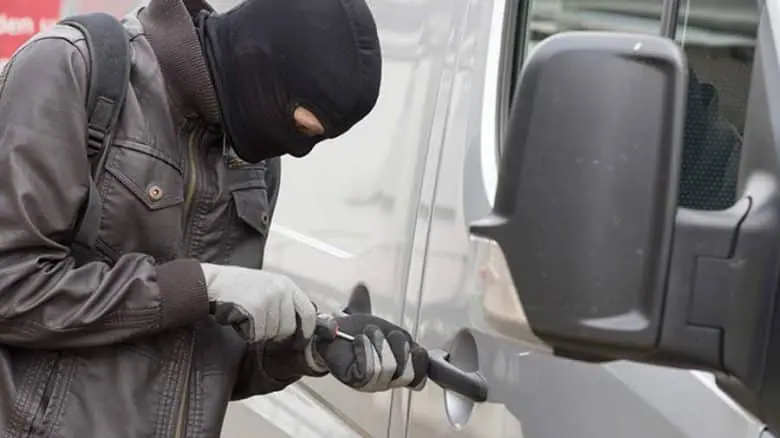
In addition to understanding the vulnerabilities of our vehicle, in order to foil a theft, it is also important to understand the psychology of a potential thief and how theft usually occurs.
In this sense, it is important to keep in mind that a thief before launching into attempting a theft will assess:
- The Ease of Break-in: how easy is it to break in and grab items? Are the doors closed? Are there any locks or signs of potential alarms?
- The Value of the Shot: are there valuable, easy-to-sell items? Can I see them from the outside to be sure?
- Chances of Success: Can I manage to escape without anyone seeing me or otherwise without being caught?
A thief, of course, will be more likely to attempt the theft in a seemingly vulnerable RV, perhaps with valuables in view, or parked in an isolated location where he might act undisturbed for a longer time.
It goes without saying that any care or detail we put into complicating each of these three points seen above will inevitably reduce the chances of theft: a seemingly well-protected vehicle, with nothing of value in sight, and perhaps parked smartly, will surely be less attractive as a heist.
1.3 USEFUL TIPS TO REDUCE THE RISK OF THEFT
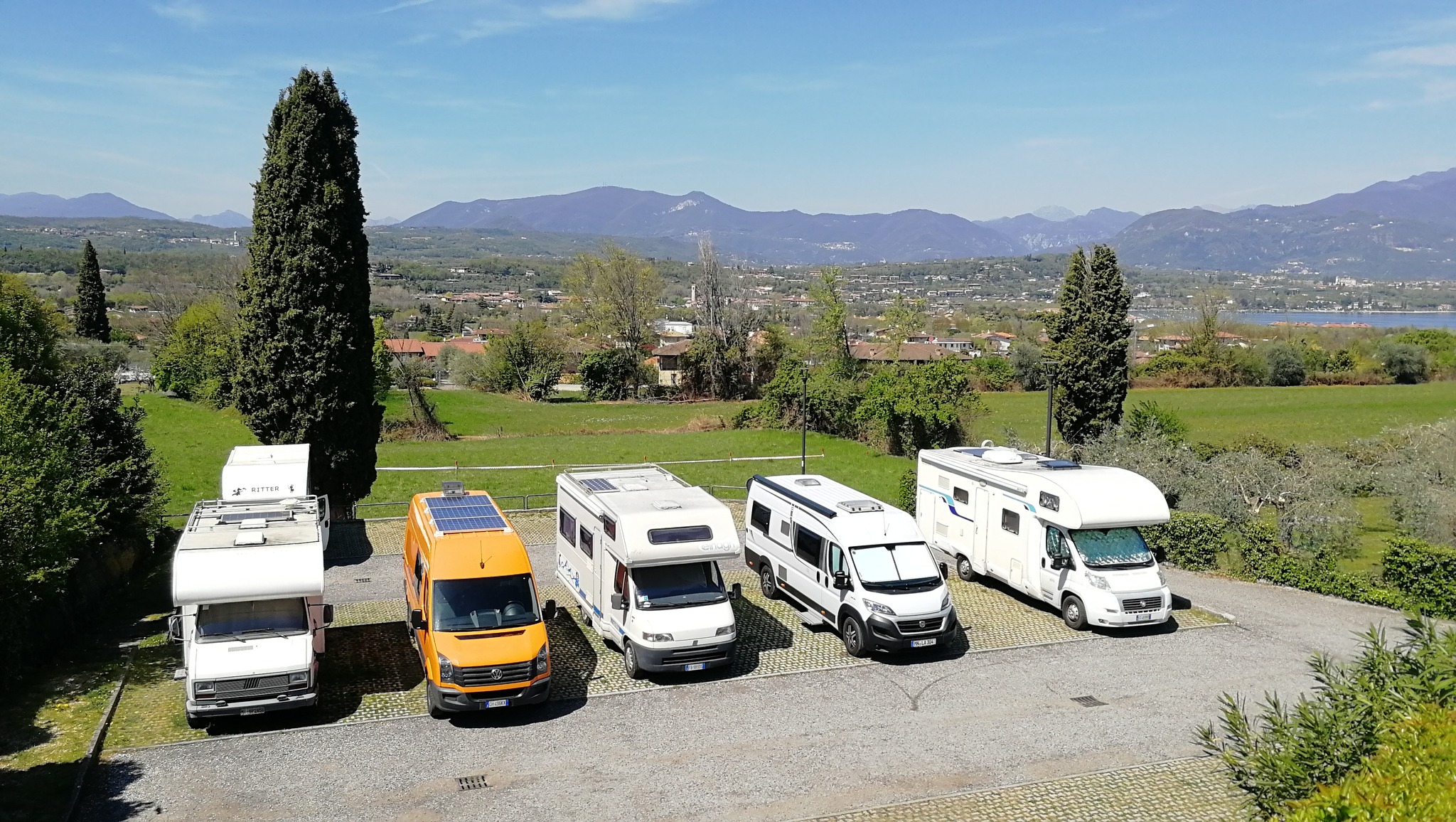
Now that we are clear about the vulnerabilities of our vehicle, and the facts of how theft in/of an RV occurs, we can think of strategies to minimize the risk. As you will see in the advice I will give, it is very important at this stage to play on deterrence, that is, to make the situation as unattractive as possible for a potential thief.
Below, I leave you with a list of useful tips:
TIPS FOR SAFE PARKING YOUR VAN / RV
- Watch for other campers. This is usually a positive sign in that the more people around, the less chance there is for a thief to attempt a heist without being seen.
- Keep an eye out for signs that give little confidence. Empty bottles, broken glass, fences and gates in surrounding houses, alarm signs etc. can all be signs that the area is unsafe. If you don’t feel comfortable in one place, the best thing when in doubt is to look for another!
- Park in such a way as to leave the most vulnerable entrances (doors and windows) in view of those passing by. A burglar is most tempted to try a break-in in a dark, hidden area where he may not be seen.
- If you don’t know a rest area, when in doubt, park where it is lighted. It goes without saying, that attempting a heist by light is much riskier for a thief than attempting it in the dark.
- Always keep a watchful eye, and never feel 100 percent safe. It is not a matter of being paranoid, and you absolutely must not stress. Simply keep in mind that you never know when something might happen, and small precautions are best taken at all times (even in a potentially “protected” area).
KEEPING VALUABLES SAFE
- Do not leave anything in the cockpit out of sight. The less you show, the better. Attempting a blind shot is not as tempting as attempting a sure shot.
- When you leave your vehicle, draw the curtains and darken all the windows. As above, leave nothing out of sight!
- Think about investing in a safe (see Chapter 6). In the unfortunate event that someone does get in, it is important that your valuables are not easily accessible anyway.
- Alternatively, place them in the false bottom of a closet, under sheets, behind jackets, or otherwise in hard-to-find places. You know your camper better than anyone, and you certainly know where items may be safest!
- Keep an up-to-date inventory of the items inside your van. In case they are stolen, it is important to have an inventory (possibly with photos!) so that you can declare everything to the insurance company.
- Download parking apps (such as Caramaps or Park4Night). With these apps you can read about the parking experiences of other campers, find the quietest and safest places and avoid the riskiest ones. If you want more information about these apps, I recommend reading the article The 15 Best Apps for Traveling by Camper. 🙂
INSTALL THE MOST SUITABLE ANTITHEFT SYSTEM(S) FOR YOUR VAN / RV
Below in brief, I anticipate the types of anti-theft devices we will discuss in the next chapters, to begin to orient you to what we are going to look at:
- Antitheft Deterrents: should be noticed from the outside, serve to give the idea that the shot is too difficult, takes too long, and is not worth the risk. These include stickers, alarms, padlocks and other flashy anti-theft devices.
- Anti-Intrusion AntiTheft Devices: these are the anti-theft devices that prevent physical access of the thief inside the vehicle. These include door padlocks, deadbolts, lock reinforcements and, in extreme cases, bars on windows.
- Mechanical Antitheft Devices: mechanical antitheft devices are devices that physically prevent the vehicle from moving: steering locks, wheel jaws, pedal stops etc.
- Electric Antitheft Devices: are antitheft devices that prevent the vehicle from starting or otherwise use electrical technology to operate. These include killswitches, GPS systems, motion alarms etc.
Normally, to be sure of doing a good job both in terms of deterrence and the actual protection of the vehicle from theft, it is advisable to install and use a combination of antitheft devices (e.g., an alarm and a mechanical antitheft device, or antiintrusion locks and alarm stickers, etc.).
While, as we have said, there is no one antitheft system that will guarantee 100 percent security for your vehicle, it is also true that combining more than one together can complicate the life of a potential attacker so much that theft is inappetible and almost impossible.
Let us now begin to see and analyze the best RV antitheft devices currently on the market 🙂
2. RV/Van Antitheft Devices : Deterrents.

The first category of RV burglar alarms we see are deterrents, which are those systems created to discourage the thief from attempting theft. Simply put, they are deterrence systems that try to convey to the thief the idea that the vehicle is not easy to steal or that it is otherwise risky to do so.
1. WARNING STICKER
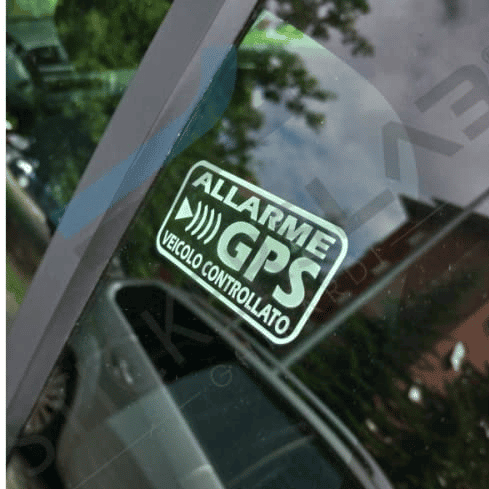
Simple sticker that can be applied to the inside of your vehicle windows, notifying a possible thief of the presence of an alarm and GPS installed in the vehicle.
A small and inexpensive deterrent, which nonetheless can make its big impact.
It works even better when combined with an alarm or other burglar alarm.
PRO
- Economical and Immediate to Apply
- Communicates a Potential Danger (Deterrent) to the Thief.
AGAINST
- Of little use unless used in conjunction with at least one more serious anti-theft device
- Simple Psychological Deterrence System
2. WIRED ALARM
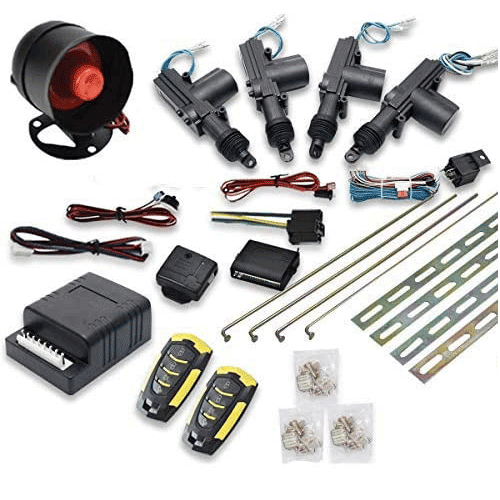
A classic alarm like the standard ones, which once armed with a remote control, sounds as soon as someone tries to force a door.
Assembly requires some familiarity with electrical wiring, but with a little good will, Do-It-Yourself assembly is possible. A wired alarm also can be connected to the vehicle lights (to make them flash continuously in case of unauthorized access).
An alarm, combined with an intrusion detection system or a mechanical burglar alarm, is usually enough to convince a burglar to abandon the heist.
PRO
- Sound can attract the attention of passersby and scare off the thief
- Ability to link it to vehicle lights for added deterrence
- Excellent system for use in conjunction with intrusion detection systems
AGAINST
- It is not super easy to install Do-It-Yourself if you are not familiar with electrical wiring (but not impossible either 🙂 )
- By itself, it will not prevent theft if the thief is persistent or the vehicle is parked in a remote and isolated place
3. WIRELESS ALARM
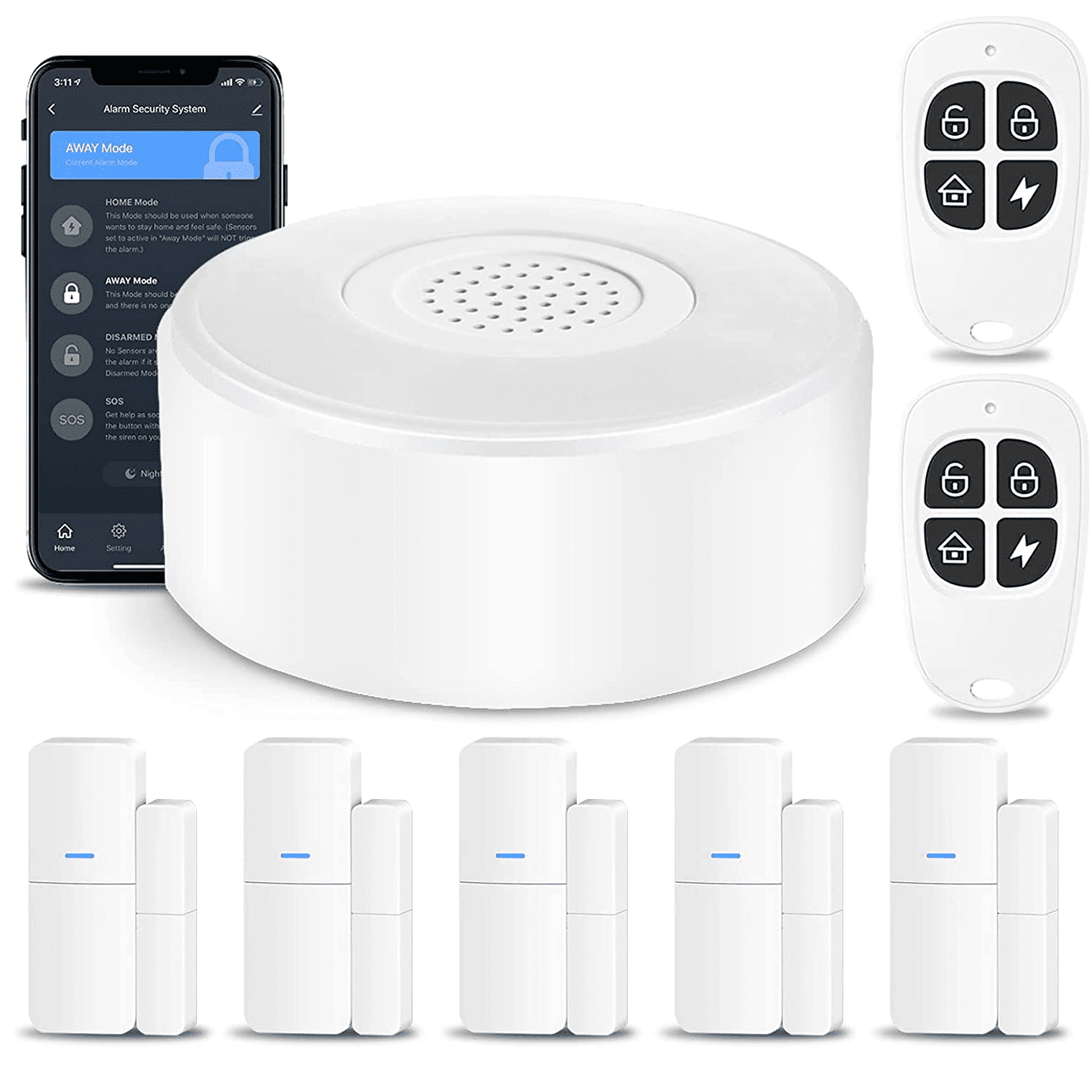
An ‘ intuitive alarm that can beinstalled in minutes and can also be monitored by phone.
A sensor is mounted on each door (with simple adhesive) that can be activated by remote control. Once the alarm is activated, it will start sounding as soon as a door (or window) is forced open, and will send a notification directly to your smartphone .
Ideal alarm for both when inside the vehicle and when leaving the vehicle parked. As in the previous case, the sound alarm works best when combined with an intrusion detection system or a mechanical/electrical burglar alarm.
PRO
- Modern Alarm Easy to Install in Minutes
- Send notification to Smartphone in case of opening
- Simple and Customizable
AGAINST
- The sensors run on batteries, which need to be replaced from time to time. The alarm requires Wi-Fi connection.
- By itself, it will not prevent theft if the thief is persistent or the vehicle is parked in a remote and isolated place
3. RV/Van Antitheft Devices : Anti-Intrusion.

The second category of RV/Van antitheft devices that we see is anti-intrusion systems, which are those devices designed to reinforce the most vulnerable parts of your RV (doors and windows) and designed to keep the thief out of the vehicle or otherwise hinder his access and stall him as much as possible.
In fact, what every thief hopes during a theft is to take as little time as possible, thus reducing the risk of being caught. Because of this, when confronted with solid anti-intrusion devices, a thief might give up and abandon the heist.
As you will soon see, theft deterrence and deterrence are factors that we will constantly find in even the most elaborate anti-theft systems: after all, prevention is better than cure! 🙂
4. DOOR CHAINS
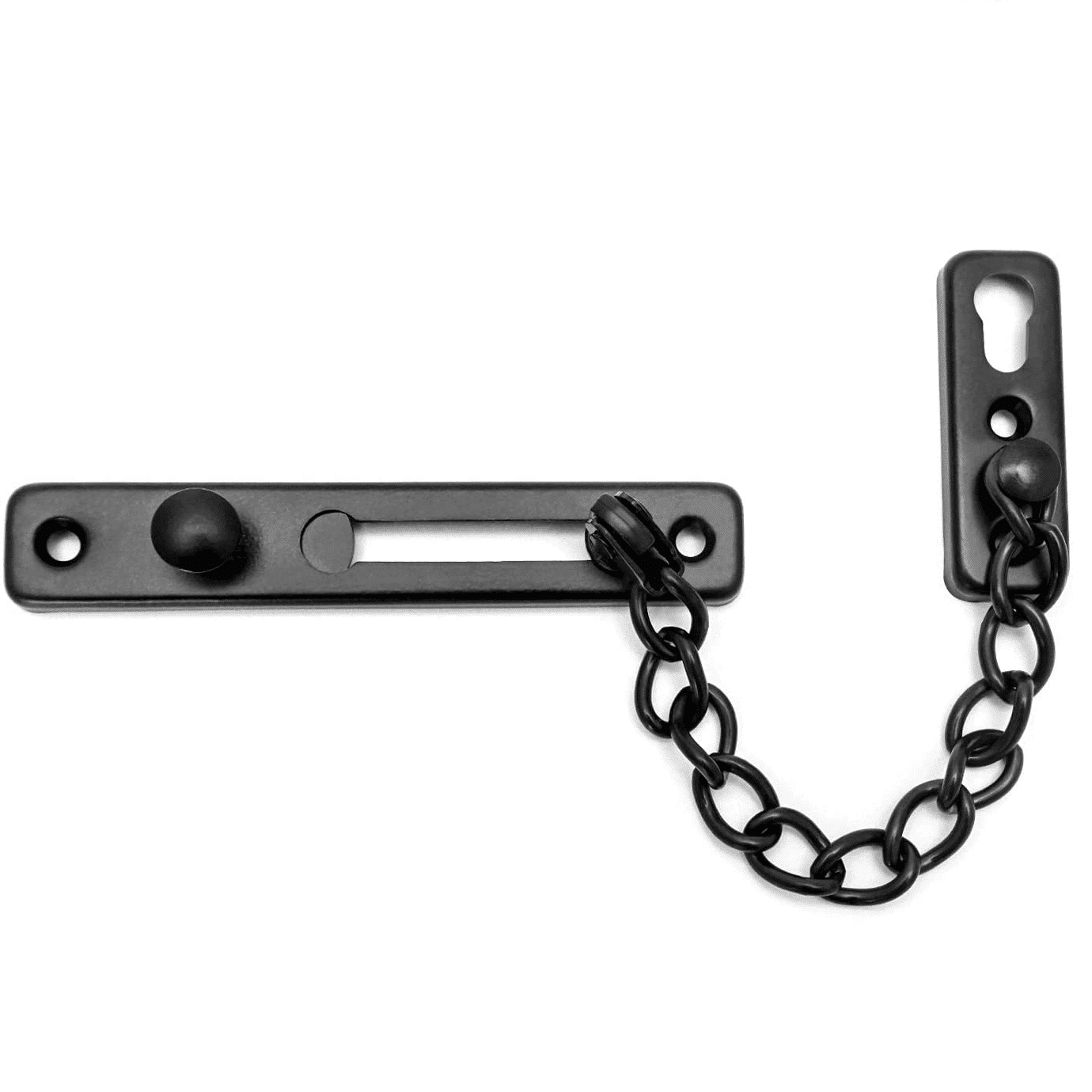
Installing a steel chain to the doors, as with a front door, can certainly be a useful way to slow down a thief and potentially put him on the run (imagine, for example, a chain combined with an alarm!). This type of anti-theft device must be activated from the inside, and therefore it is not possible to put it on all doors.
PRO
- Very cheap
- Quick to Assemble
- Slow down the Thief who doesn’t see it coming
AGAINST
- Chain can be cut with the right tools
- It should be inserted from inside the vehicle
5. BURGLAR-PROOF FOR LOCKS
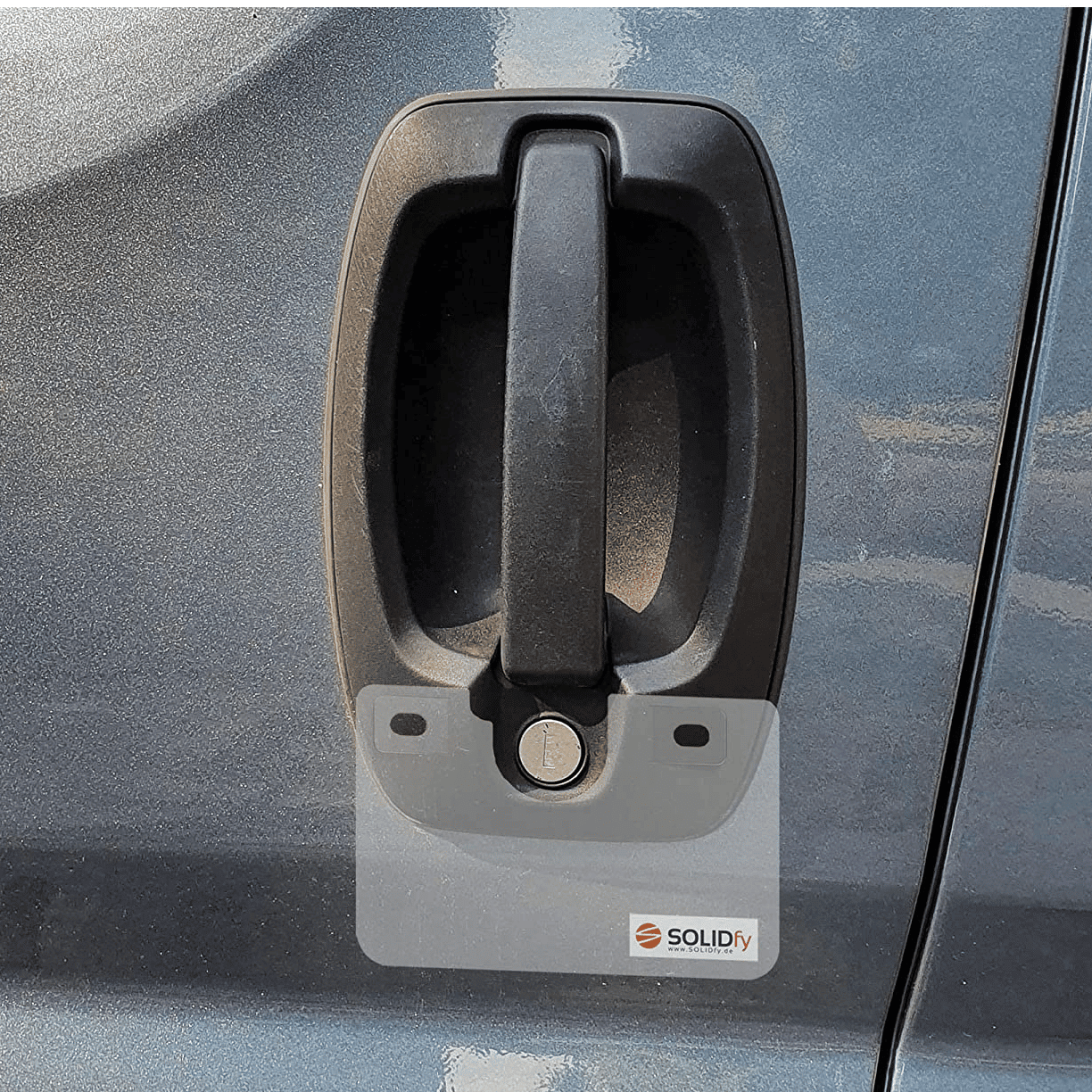
One of the most common ways used by thieves to break into locked vehicles is to drill a small hole just below the door lock in order to activate the release (this can also be done with a simple screwdriver!).
Burglary guards for locks, nothing more than stainless steel cards that protect the opening system and block tampering attempts.
PRO
- Economical Anti-Effraction Mechanism
- Do-It-Yourself Mountable
AGAINST
- Be sure to get the one Specific to your Vehicle Model
- A stubborn thief, he could break a glass
6. DOOR LOCKS
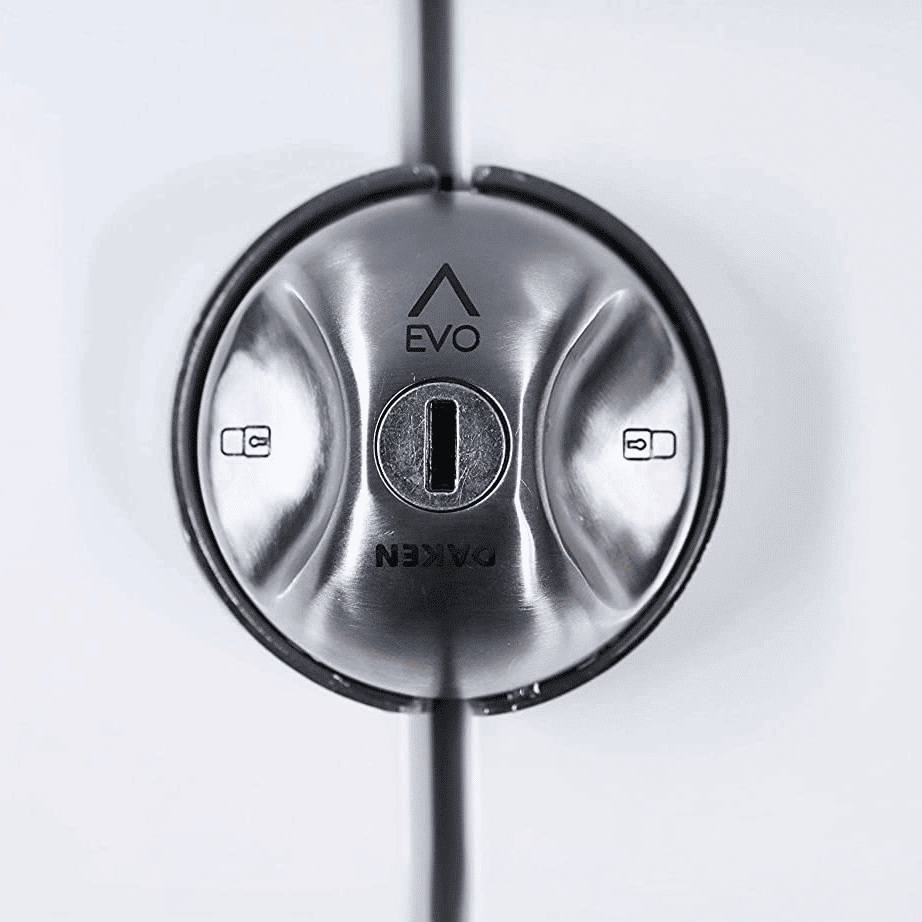
Clearly visible and solid, door locks are extra locks that can be bolted to the inside of your vehicle’s doors (perfect for camper vans!).
Personally, I think they are the best anti-intrusion burglar alarm currently on the market: they create both a deterrent effect by sight, and they are damn hard to break into from the other (they are used especially in vans carrying valuable goods).
PRO
- The best anti-intrusion antitheft devices on the market
- Deterrent to eyesight
- Solid and difficult to break into
AGAINST
- High Price
- One is needed for each door
- Assembly Requires Time and Precision
7. FLAME SAFE DOOR
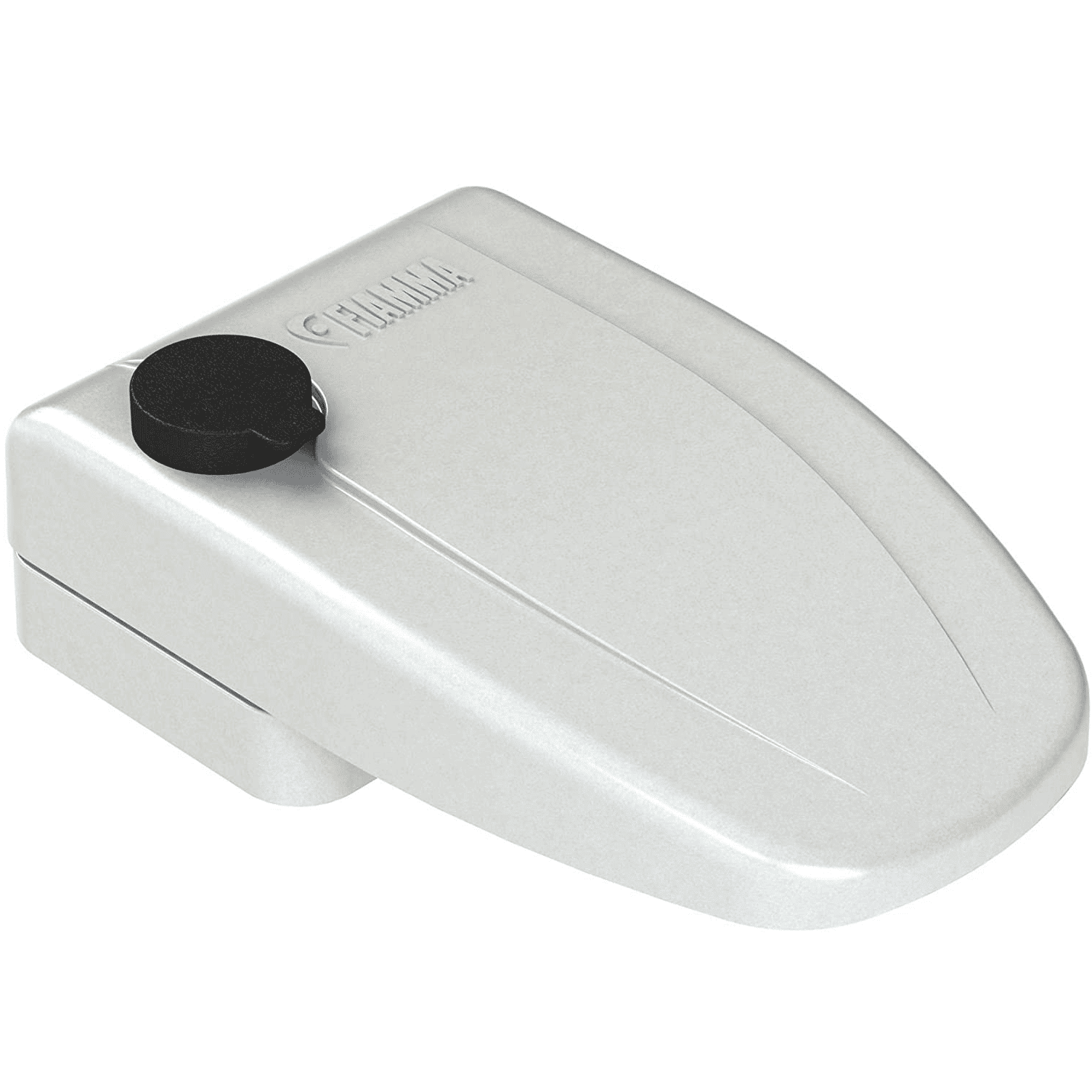
Flame safe-doors are metal accessories to be installed around RV doors or lockers (they work well with factory RVs, less so with camper vans) that prevent unauthorized opening .
They mount next to the door and, when needed, turn and lock with a key, making it impossible to open.
PRO
- Good Value for Money
- Visible, they create deterrence
- Difficult to Break into
AGAINST
- Assembly Requires Some Time and Precision
8. FIAMMA DUO-SAFE ROD

Tying the front doors together with a rope to block their opening is an old anti-intrusion technique that has been around for a long time.
Fiamma’s Duo-Safe rod is a quicker and more practical solution that mimics its operation: thealuminum rod stretches perfectly to fit into holes in glass or between door handles, and once locked in place does not allow doors to open even an inch.
It is certainly an inexpensive and interesting solution to secure the front doors, and thus leave only the side door to be defended (for example, with a door lock).
PRO
- Price Lower than other door lock systems
- It is visible and may deter the thief from trying the heist
- Lock two doors with one apparatus
AGAINST
- It could lead the thief to break a crystal
- Only for the front doors
4. RV/Van Antitheft Devices : Mechanical

The third category of RV antitheft devices we see are the mechanical antitheft devices, which are those devices that “mechanically“ prevent the vehicle from moving or being maneuvered properly.
As you will notice, many of these devices are created in very garish colors to be noticed easily by the thief and to be conspicuous (again, we find the deterrence effect with the goal of making the thief abandon the heist before trying)
9. STEERING WHEEL LOCK
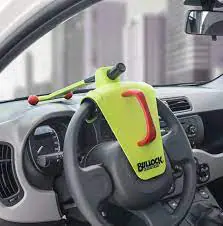
Steering wheel locks are accessories usually made of steel that, when firmly attached to the steering wheel and secured with a special key, prevent the steering wheel from turning (and thus make the vehicle driveable).
There are various models, shapes, and colors (usually garish to create deterrence), but they all generally work the same way.
Useful to slow down or deter the thief; important, however, is to keep in mind that with enough time and the right tools they can be tampered with.
PRO
- Cheap Price
- They are an added protection against Theft
- Bright colors create a deterrent effect
AGAINST
- An experienced thief with a little time can tamper with or break into them
10. WHEEL LOCK JAWS
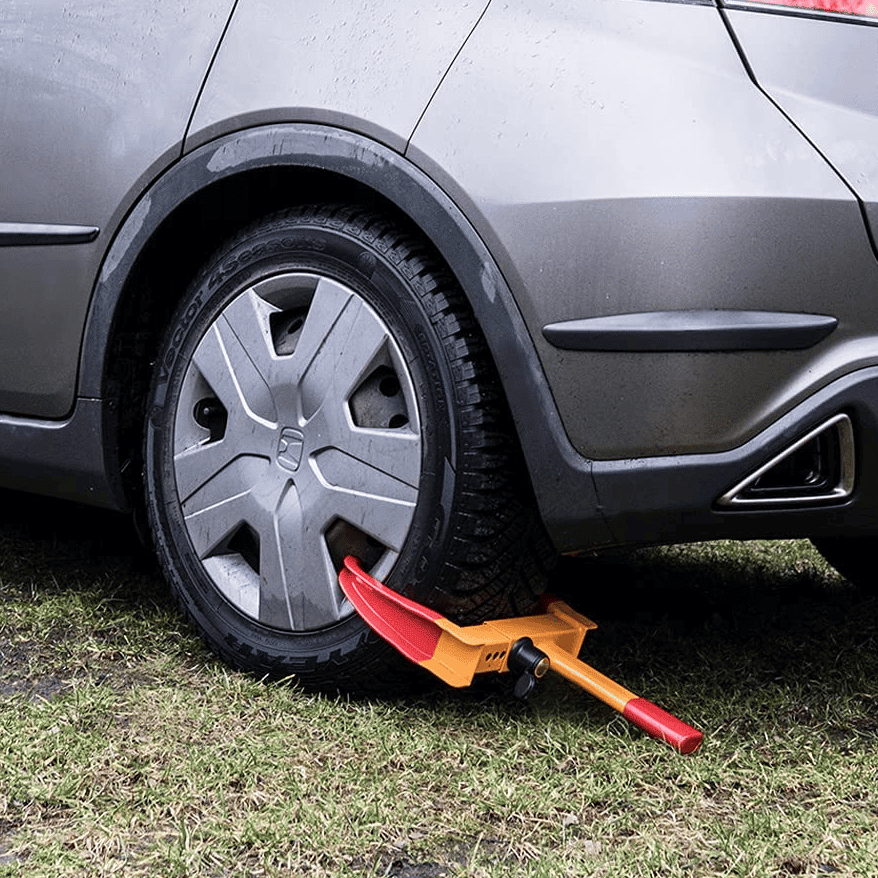
Wheel locking jaws are another metal device that, as you might guess from the name, are attached to the wheels of the vehicle and block their rotation .Jaws are also used by police to lock cars that need to be removed, which certifies their functionality!
They are not impossible to tamper with, but they certainly require a lot of time and skilled hands. Being outside the vehicle then, a tampering attempt could give passers-by an eyeful: too visible = less likely to happen! Requiring a bit more time than other anti-theft devices to mount/dismount, the jaws are better suited for those who make long stops, rather than traveling every day.
PRO
- Good security against theft/price ratio
- Difficult to Tamper with
- Bright colors create Deterrence
AGAINST
- They do not protect against theft of objects
- Bulky and Annoying to Install/Remove each time
11. STEERING LOCK + PEDAL LOCK
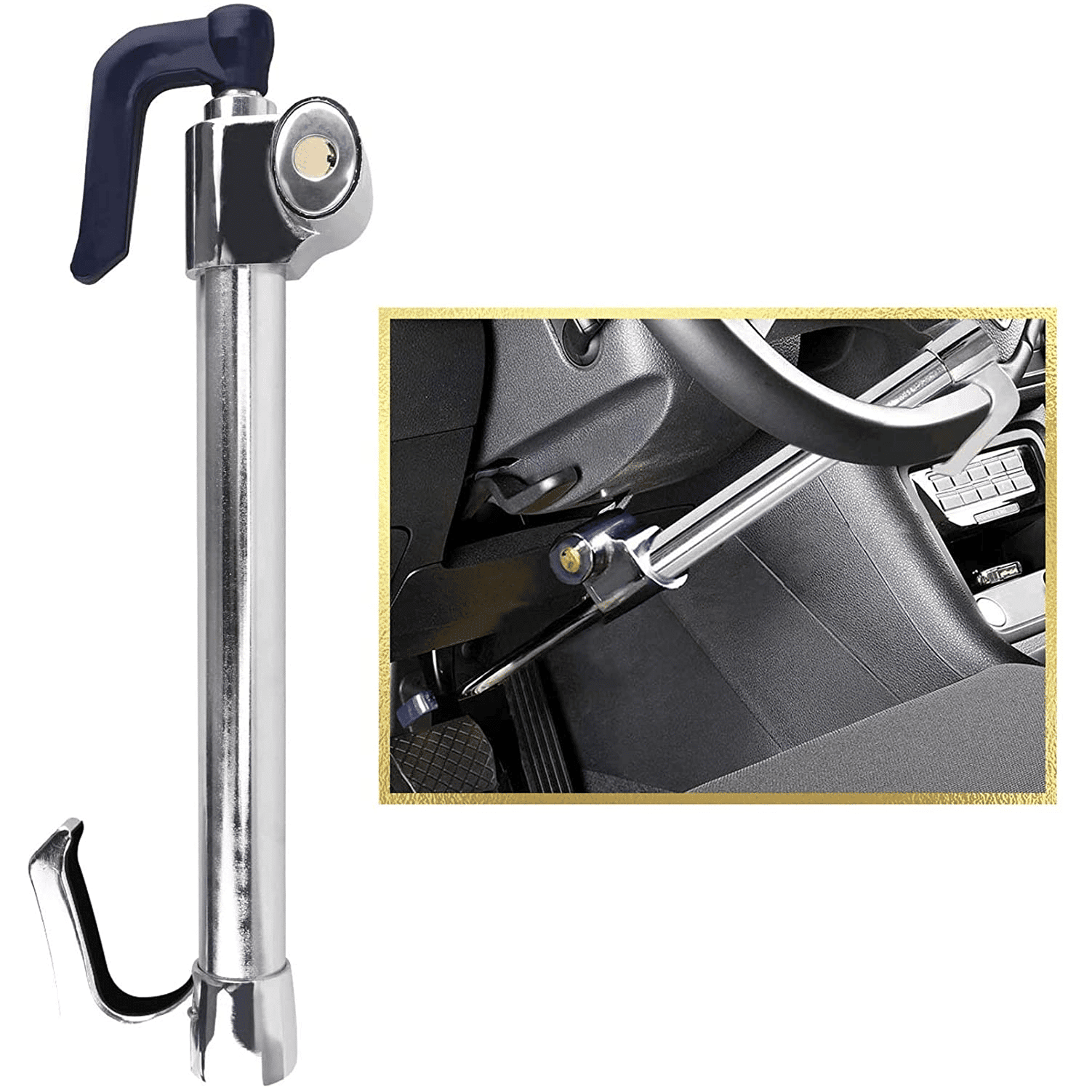
Simple and ingenious, the steering wheel + pedal lock is an adjustable steel bar that allows you to block both the rotation of the steering wheel and the mobility of a pedal (clutch or brake) by simply strapping them together.
Like other mechanical anti-theft devices, it is not inviolable, but it certainly takes its fair share of time to unhinge (and let’s remember, a potential thief is in a hurry!). This is the mechanical anti-theft device I chose for my VW Crafter.
PRO
- Good Price
- Intuitive, robust and easy to apply
- Combines steering lock and pedal lock, prevents driving
- Sight Deterrent
AGAINST
- With Patience and Time it can be tampered with
12. LOCK-PEDAL
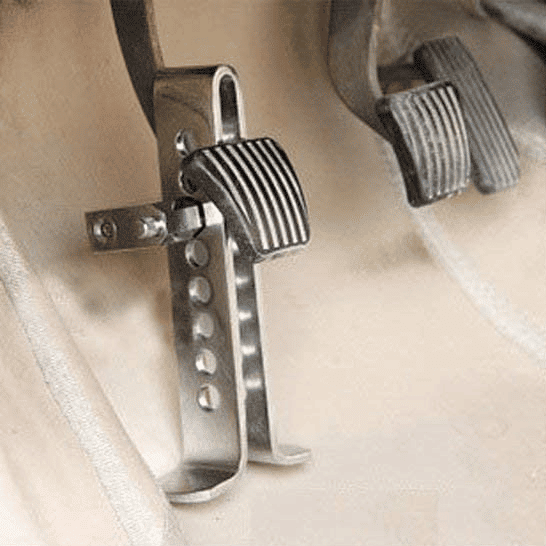
The pedal blocker normally consists of a thick, adjustable steel bar that is attached to the brake or clutch pedal and prevents its use.
Its location makes it inconvenient to cut and therefore almost impossible to tamper with quickly.
PRO
- Simple but effective
- Robust and difficult to tamper with
AGAINST
- A bit awkward to assemble and disassemble
- You need to make sure you find one that is compatible with your vehicle’s pedals
13. BLOCK-SHAFT
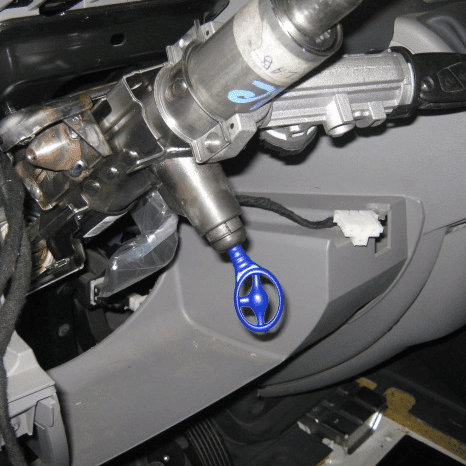
Block-shaft is probably the best mechanical anti-theft device out there, and because of that obviously the most expensive (300-400Euro).
Essentially, it involves changing the vehicle’s steering column to a certified block-shaft column (and guaranteed for the life of the vehicle) that can be locked using a key induplicable. Without a key, the steering wheel will not be able to turn and the vehicle cannot be driven.
PRO
- Close to 100 percent safety
- Impossible to Tamper with Without a Workshop
AGAINST
- High price
- There is no deterrence effect, so the thief might still force a door/window before abandoning the heist
- Does not protect against towing
5. RV/Van Antitheft Devices – Electric and Digital

Electric or digital antitheft devices, are burglar alarms that work with electric current which take advantage of new technologies (GPS, WiFi, Rooms etc.) to deter, hinder, locate or track the thief. There are various types and for all budgets. Below I show you the ones that I think are currently the best on the market (and that I have installed!).
14. KILLSWITCH
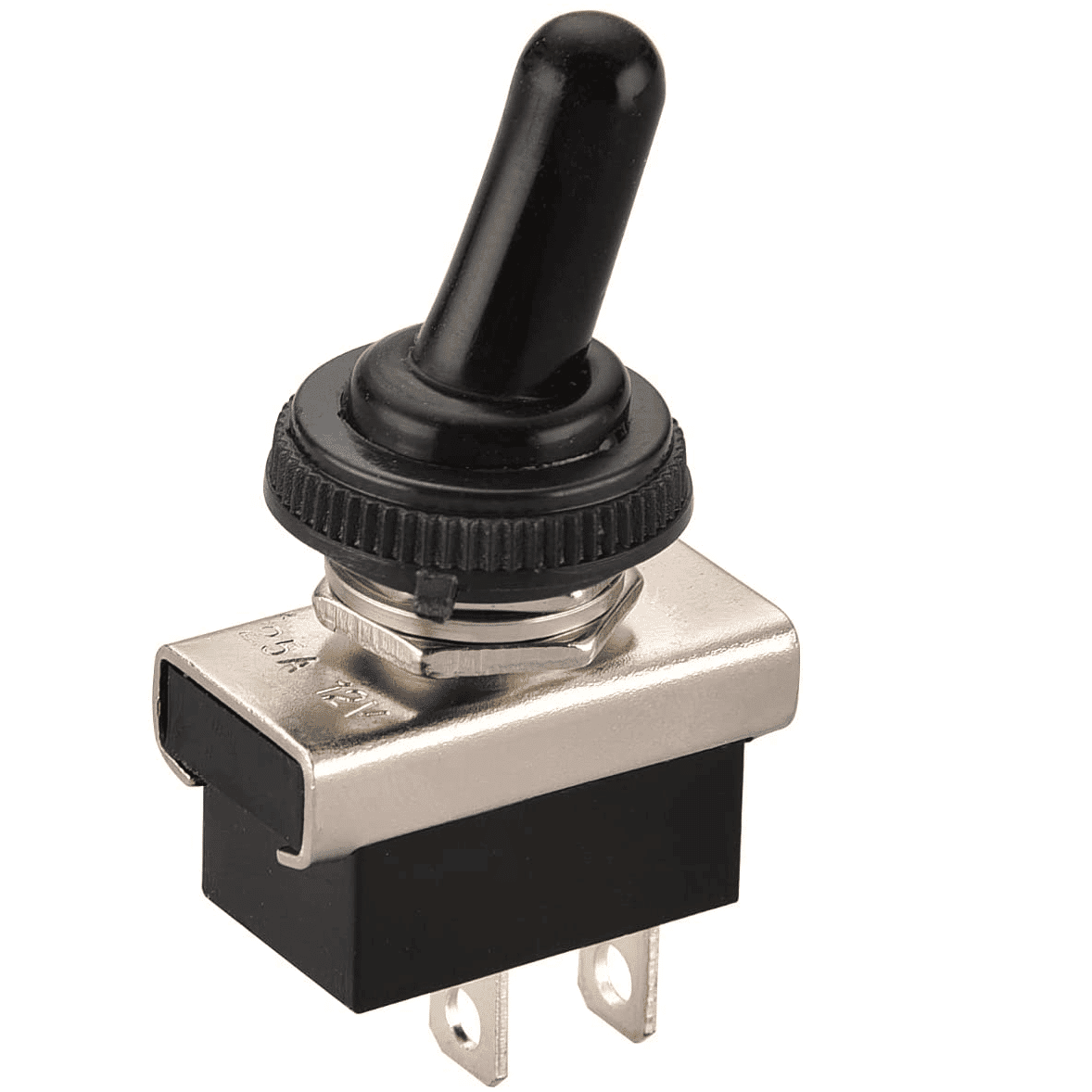
When you insert the keys and start a vehicle, the 12V electricity from the batteries goes to power all the components of the vehicle that are needed to start it.
The killswitch, nothing more than a Very simple 12V switch that can be plugged into a circuit that is essential for startup of the vehicle (e.g., before the fuel pump, between the pump relay and the fuse box, on the ignition circuit etc.) and hidden somewhere only you know where.
Once set to “off,” the vehicle cannot be started. Not knowing what the problem is nor where to look, a potential thief is likely to flee after a few attempts.
(Note: An in-depth article will be coming out soon in which I show you how I assembled mine:)
PRO
- It costs less than 10 Euro.
- Works great against Theft
AGAINST
- Requires some work and skill with electricity to be installed
15. MOOX GPS TRACKER
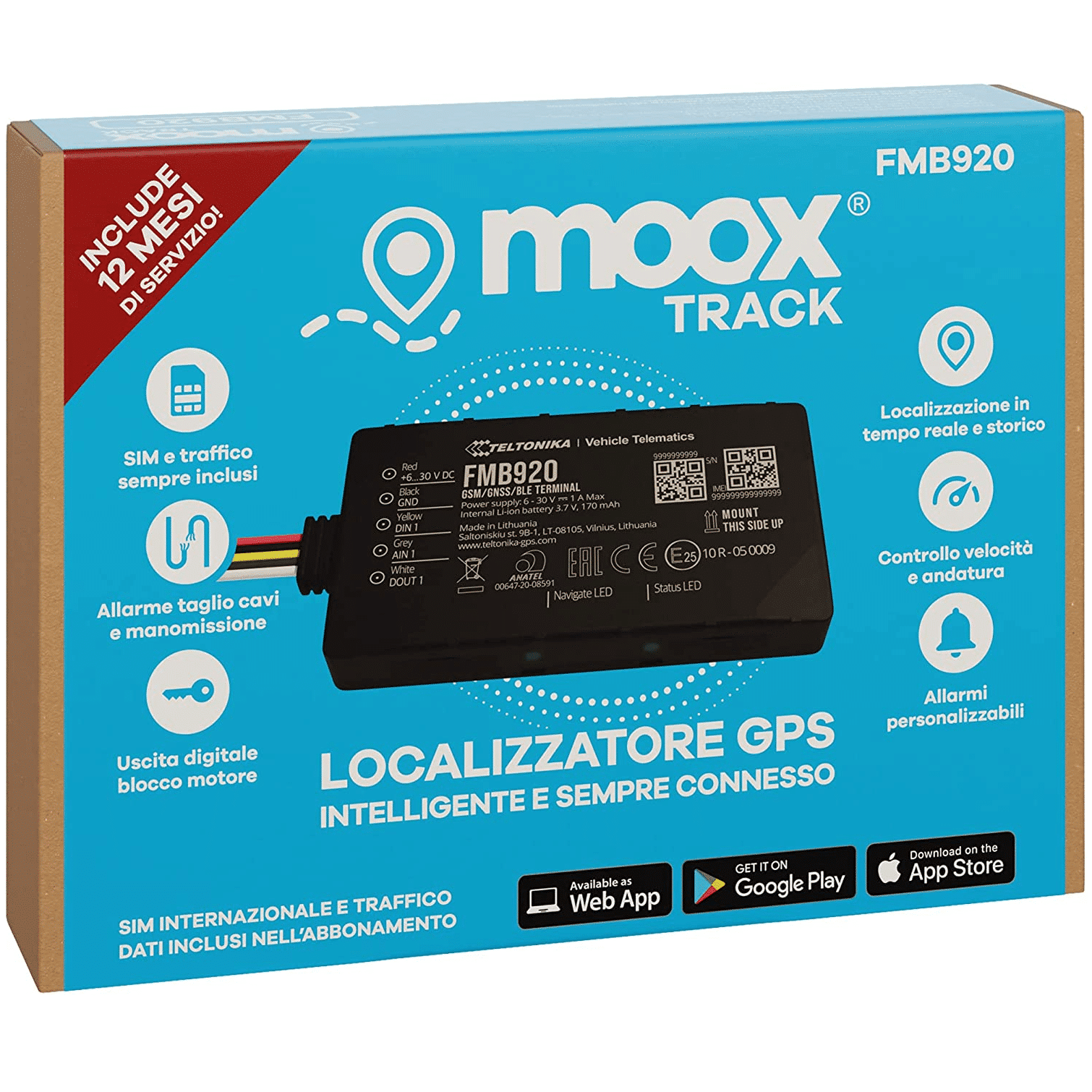
A GPS tracker helps to quickly find the vehicle if it is stolen, and I personally consider it a yes-or-no thing to install.
Personally, I chose to install on my camper van a Moox Track, which I consider one of the best built and thought out GPS anti-theft devices.
Through a outstanding smartphone app in fact, it is possible Know the real-time location of the vehicle, direction, speed, motor battery voltage, on/off status, as well as keeping a history of all trips made (with times, kilometers, and locations) and receiving notifications when any abnormal movement occurs.
Always connected, with coverage in over 100 countries, and with notification even in case of tampering, Moox Track I believe is the best GPS anti-theft device currently out there.
PRO
- Keeps an eye on and records the location of the vehicle at all times
- If everything goes wrong, it is still easy to find the stolen vehicle
- Send a Notification if the vehicle is turned on or moves without permission
AGAINST
- By itself, it does not prevent theft or intrusion
- Medium-high price
6. How to Keep Precious Objects Safe.

Last, it is important to think about how to secure your valuables in the unfortunate event that a thief manages to break into your little house on wheels.
In our case for example, we often happen to leave the computers we work with in the RV, or perhaps a camera or drone (they are heavy to carry around all day if not needed!).
At present, we are leaving them in the most hidden recesses of our van, so that they are not easy for a hurried thief to find anyway. Below I leave you a few photos of some of the places we sometimes use:
In the little bench under the pillows

Under the induction hob

Over Driving Cabin + Padlock
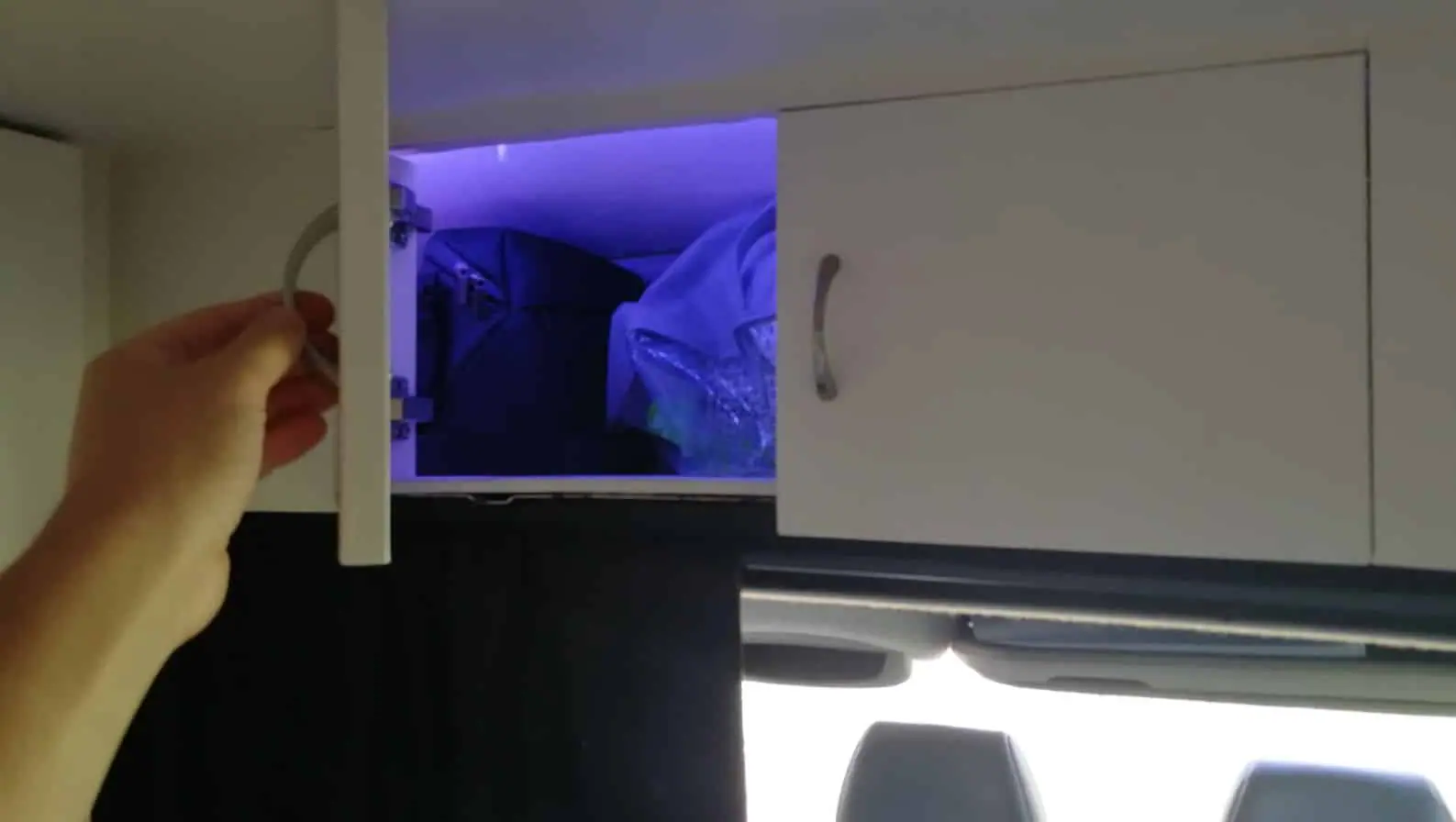
In addition, we noticed that having installed a UFO3 on the rear doors, thegarage area under the dinette basically becomes a natural safe, which would require straining both the rear UFO and the door lock (very difficult).
That said, surely you know your vehicle better than anyone else and so surely you are the best person to identify the best places to leave your valuables.
Other ideas that can help safeguard one’s items may include:
- Drawers with double bottoms,
- Cabinets with double walls,
- padlocks to furniture,
- Behind the refrigerator,
- In the garage,
- Install a small safe.
In the case of the safe, it is very important to attach it to the structure of the vehicle so that the thief cannot steal it all in one piece (under the seats is a good place to attach it for example).
Below I show you 3 types of RV safes that you might be interested in.
Small Casket
for Personal Objects
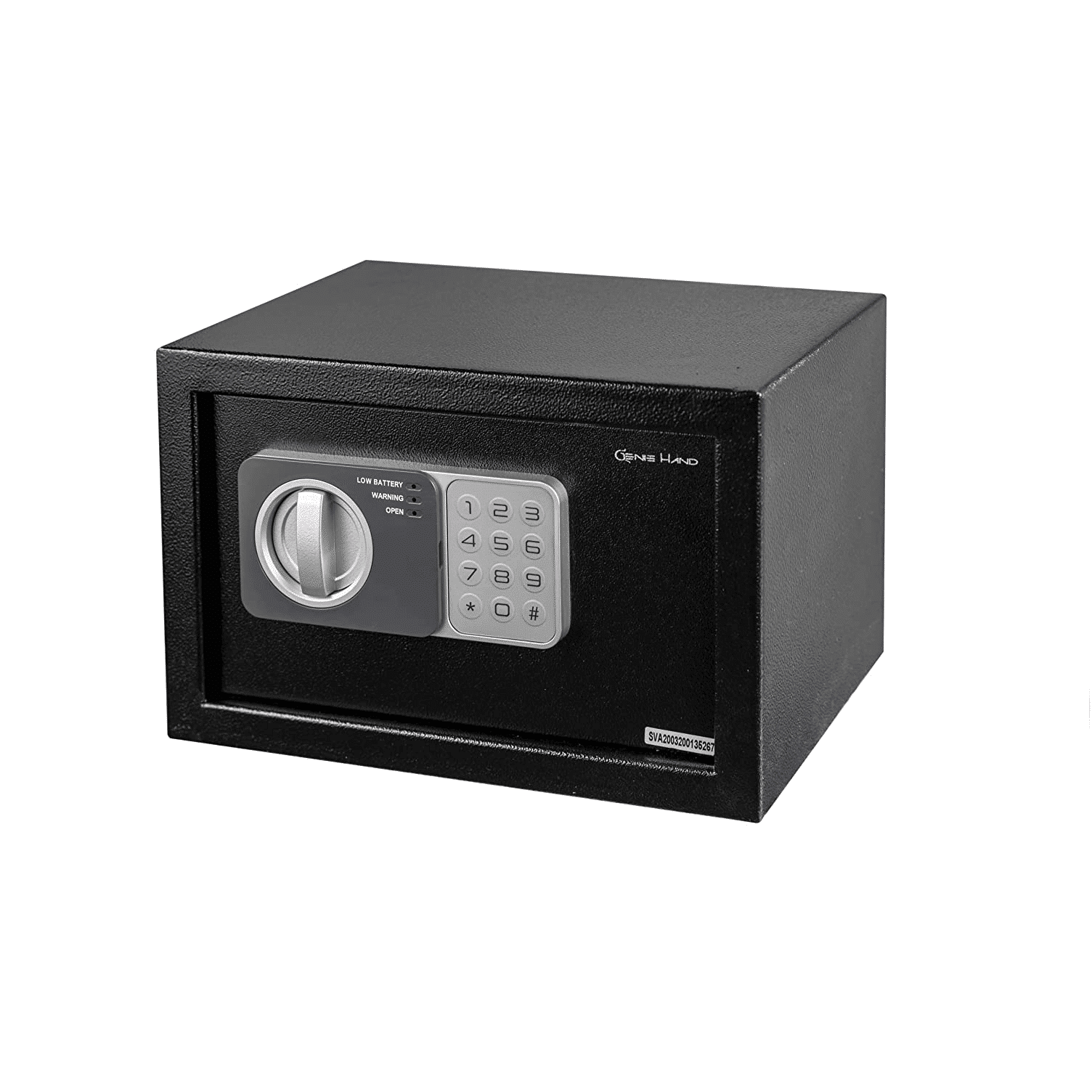
Media Case
for Travel Laptops
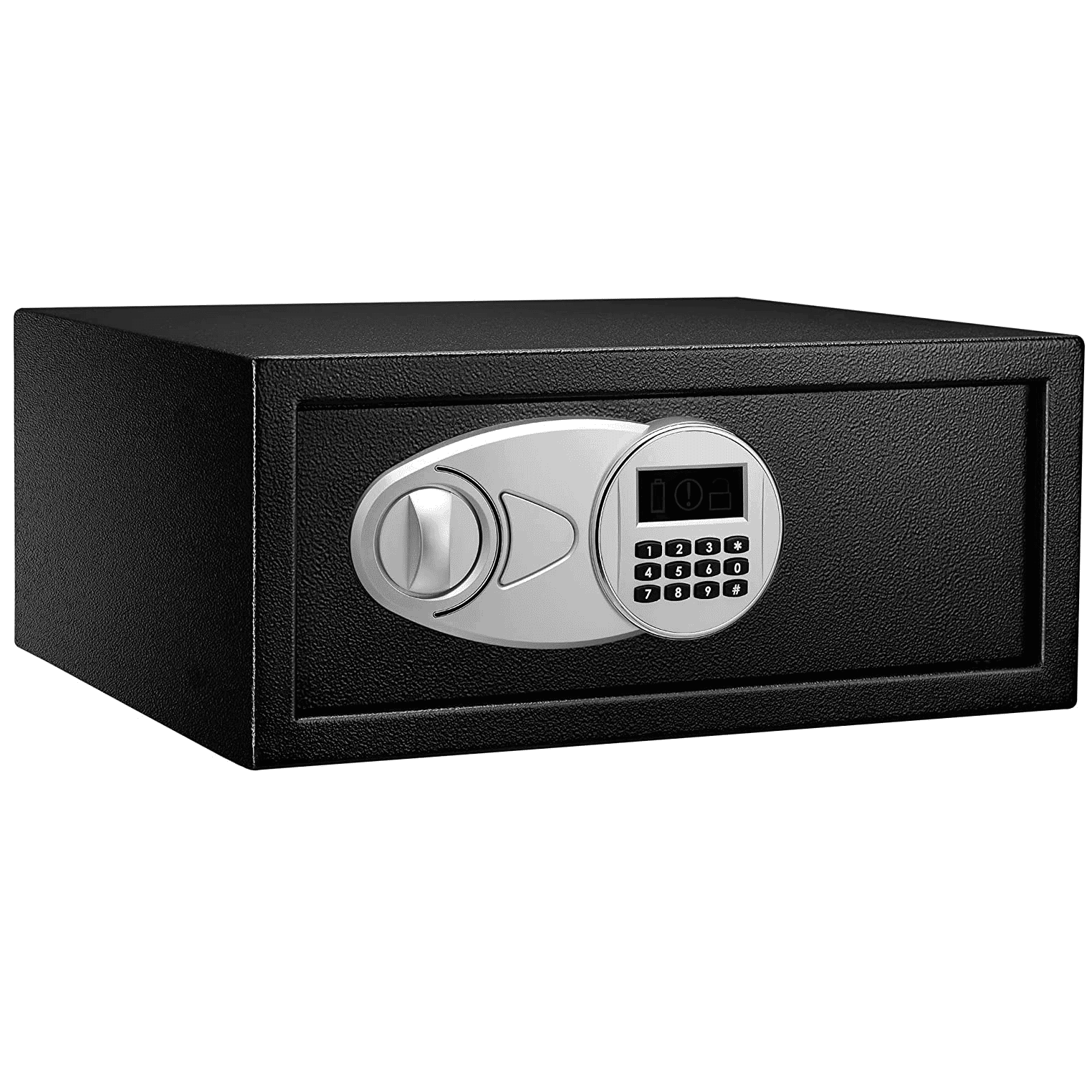
Cassafore Grande
for Large Laptops and Cameras
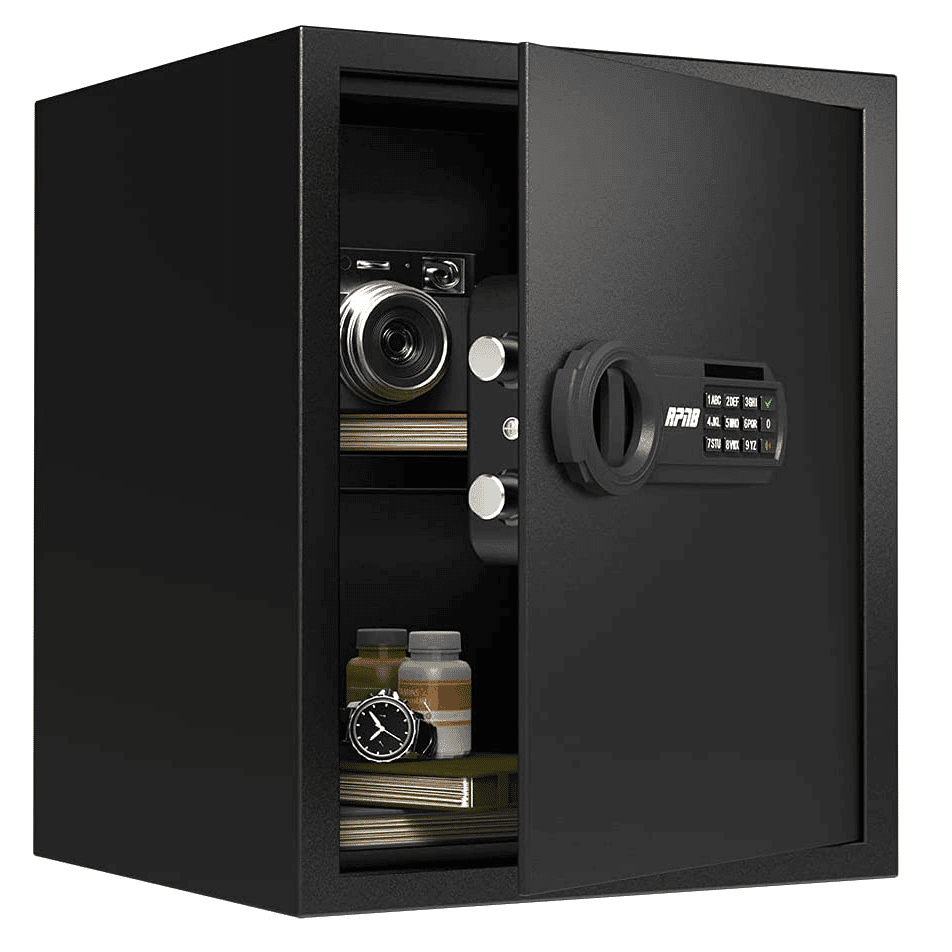
We are currently planning a world tour starting in the fall, and although we have not yet installed a safe at the moment, we are sure that we will definitely install one before we leave. Leaving one’s most cherished items unattended in the van, even if well camouflaged and hidden, never leaves us 100 percent comfortable.
7. My Choice and Conclusion

After a long and exhausting search for the best anti-theft device for our camper van, I have concluded that the optimal solution to keep our vehicle safe is not to rely on ONE anti-theft device, but a COMBINATION of multiple anti-theft devices.
As a theft deterrent, besides of course always blacking out the windows from the inside before leaving the vehicle unattended, we applied inexpensive alarm-GPS stickers on the inside of the front windows.
As anti-intrusion systems, we have installed door locks Ufo 3 on the back and side doors (Made in Italy) and we use a Fiamma Duo-Safe Rod (very practical to lock and unlock) for the front doors.
As a mechanical anti-theft device, we use this steering lock+pedal lock.
On the electronic antitheft systems, on the other hand, I think we’re pretty well set up: I installed a killswitch hidden to prevent the vehicle from turning on, and installed the anti-theft device GPS Moox Track to receive cell phone notifications and monitor the location of our van h24, so that we can easily track it in the unfortunate and remote event that someone manages to steal it anyway. Furthermore, it also notifies me in case the van would feel any “strange” vibration or movement.
Lastly, it should be noted that the way I wired the GPS, the Moox Tracker app alerts me if a power-up attempt occurs (although then this will not be possible thanks to the killswitch that does not allow the fuel pump to be operated): a way to gain valuable time (as long as the thief is trying to figure out why the vehicle will not turn on, I will have some time to act).
These are the solutions that I have adopted at the moment on my VW Crafter orange: they are not perfect, surely we will add more in the future, but for the moment I think they are what suits us best (also considering our budget).
What about you, what experience do you have with anti-theft systems for RVs?
Do you have any experiences, suggestions, tips, or know of other devices not included on this page that you would like to share with other readers?
Or would you simply like clarification regarding some of the topics covered?
Let me know in the comments below and I will try to help you with anything I can 🙂
Thanks for reading, and as always, see you in the upcoming insights!! 😀
BEFORE YOU GO, CAN I ASK YOU FOR SOME FEEDBACK?
Writing detailed articles like this takes a lot of time and effort..
If you liked it, can I ask you to leave me a feedback message in the comments at the bottom of the page?
For a content-creator, knowing that you are being read and that your efforts are useful to someone is the best motivation to keep writing and doing better 🙂
Let me know what you liked or what you think could be added.
If you’d like, you can also share the article to help other people find it!
Thanks for the help 🙂

Read the Van Conversion Guides
How to Calculate the Right Section of 12V Cables | EASY GUIDE
An undersized cable does not carry enough current. A cable that is too undersized can lead to a fire. An oversized cable, on the other hand, simply costs more and is a waste of money. Are you wondering what is the logicfor choosing one section of cable over...
Bluetti vs Ecoflow | Which is the Best Portable Power Station for RV/Vanlife?
The Portable Power Station is an increasingly used accessory on camper vans and RVs, but when does it really make sense to purchase and own or install one? In this article we try to shed some light on how these systems work, the best options on the market, and the...
Van Conversion DIY: How Much Does It Costs? | My Experience
How much does it cost an entirely DIY van to campervan conversion? The queen of all questions... In this article, I want to show you all the costs of my conversion from start to finish, so that you too can get an idea of what it might cost! ...
Van Electrical Diagrams for your DIY Project – Ready to Install
The Electrical System is often one of the most complicated steps in a DIY van conversion. How much energy is needed? What apparatus/devices to purchase? How to connect them? How much would it cost? These are all doubts and questions that normally everyone finds...
Van Interior Conversion: Best DIY Ideas for your Project!
The Interior Outfitting of a DIY converted van is both an aesthetic and structural choice. In this article, you will find useful information and inspiration ideas for customizing the Walls, the Ceiling, and the Floor of your Van! DIY CAMPERVAN SET-UP:...
Kitchen for Camper | Best DIY Ideas for your Van Conversion
Cooking in Camper is one of those things, that makes you feel at home wherever you are! Gas, Diesel or Electric Stove? What equipment and accessories you need on the Road? How much space do you need? How to assemble the kitchen in your Camper? In this article you will...
The Best Fridge for Your Campervan – Which One to Choose?
Buying a trivalent or compressor RV refrigerator? Horizontal or vertical? 12V or 110/220V? In this article you will find all the information you need to choose the best fridge for Your Van, tailored to your Needs! 🙂 THE REFRIGERATOR IN THE VAN:...
Van Conversion: How to Build a DIY Bed for your Camper Van
A Camper is not a Camper if it does not have a bed. Where to Sleep and... Dream! In this Guide you can find the inspiration you need for creating a DIY Bed in Your Campervan, And I'll show you step by step how I built a Complete Bed/Dinette on my VW Crafter....
DIY Camper Bathroom: How to Self-Build a Toilet
If you are Campering a Van you surely must have wondered: How does the Bathroom in a Motorhome work? In this Guide I show you the various types of Bathrooms on the market, I explain how they work, and I show you how you can Build yourself an entirely...
Best 12V Fan for RV | DIY Installation Guide | Van Conversion
A Roof Fan helps keep your Vehicle's humidity under control and change stale air. In this guide you will find everything you need to know about mounting a Maxxfan Deluxe fan on the roof of YOUR van. ROOF FAN: WHAT IS IT FOR? Keeping an RV's...
How to Build a Shower in a Do-It-Yourself Camper
A Shower in the RV for some people is not necessary, for others it is a real necessity to be totally independent! In this guide I'll tell you how I built the shower of my converted van entirely Do-It-Yourself! INSTALLING A SHOWER IN A...
Complete Guide and Electrical Scheme for your D-I-Y Van Conversion
You dream of transforming your Campervan DIY and have never touched an electrical cable before? Or do you want to implement some changes to your Factory RV? In this guide you will find EVERYTHING (absolutely EVERYTHING!) you need to know to create the perfect DIY...

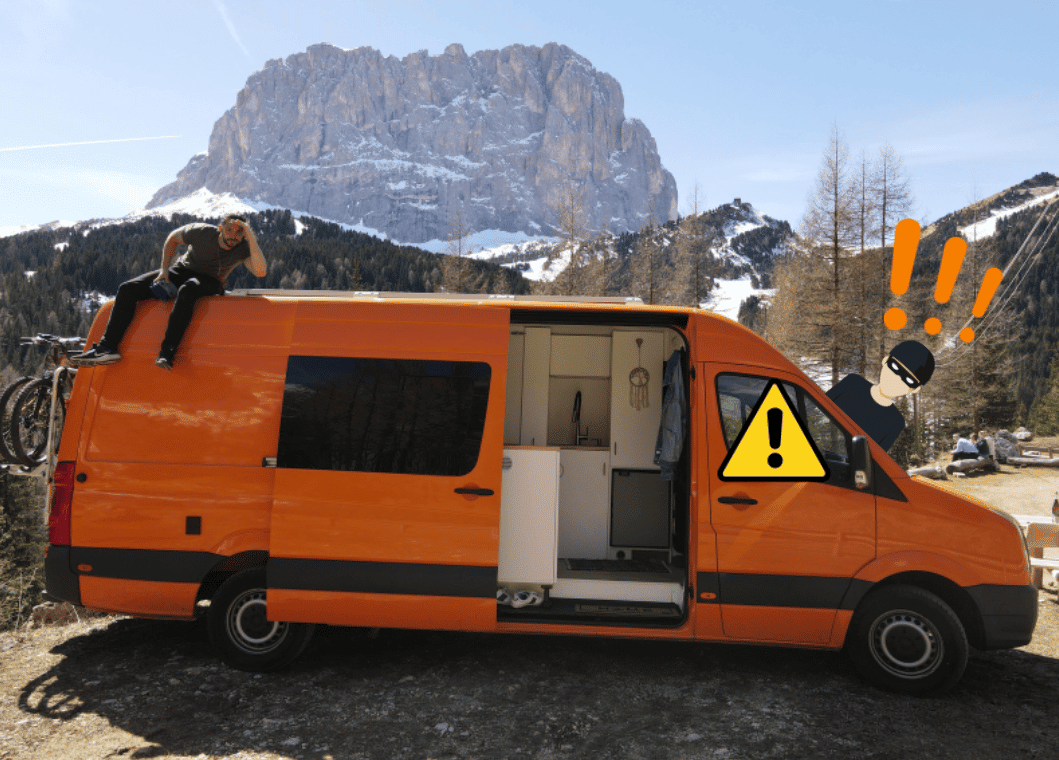
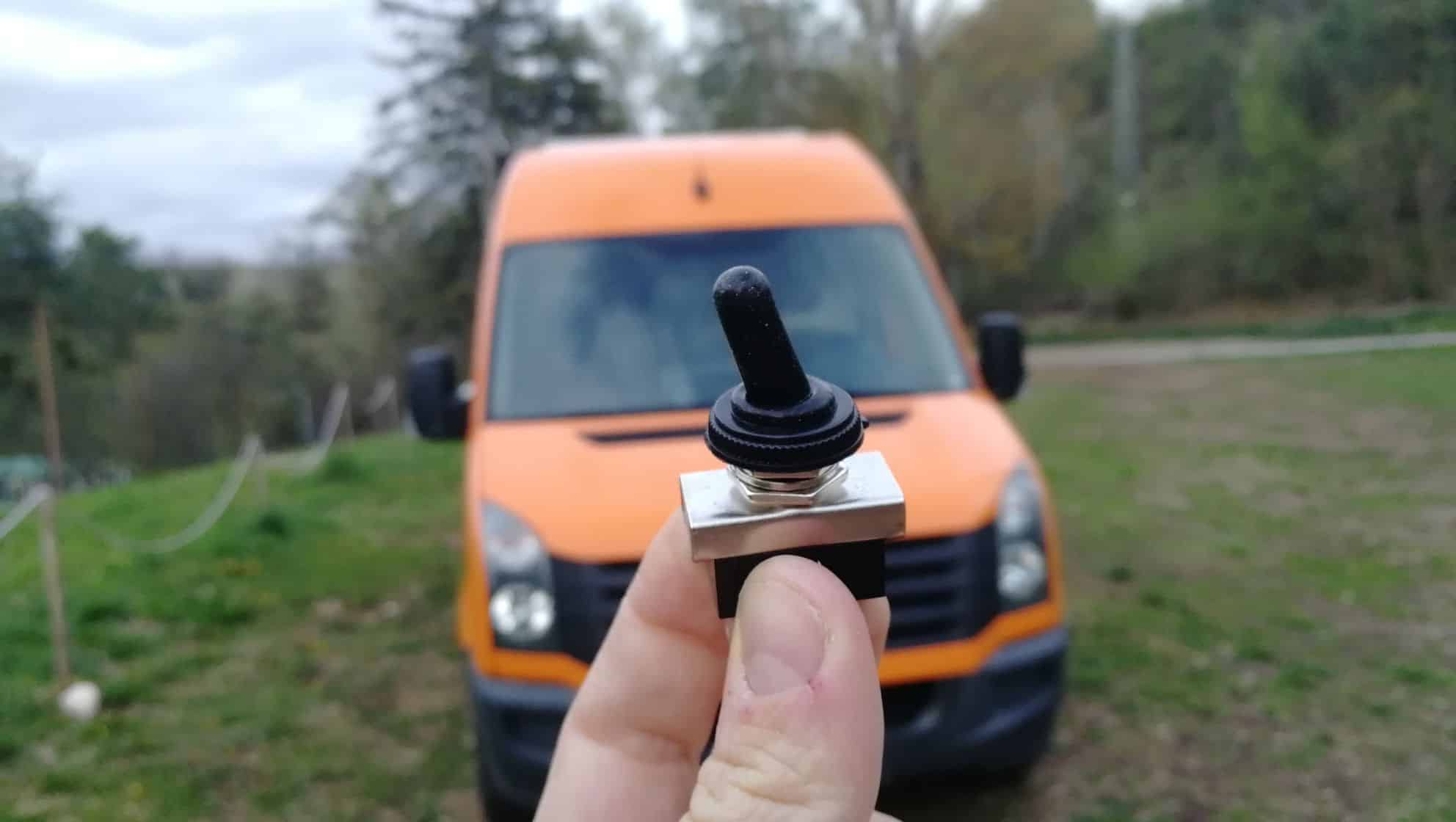
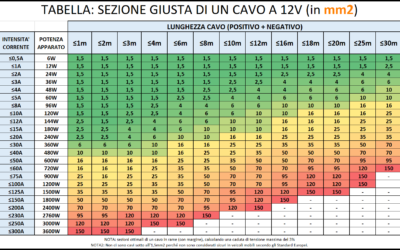
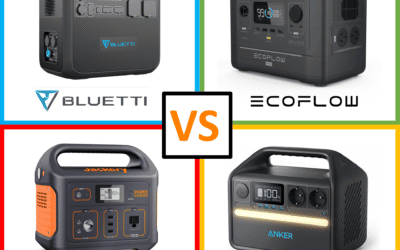

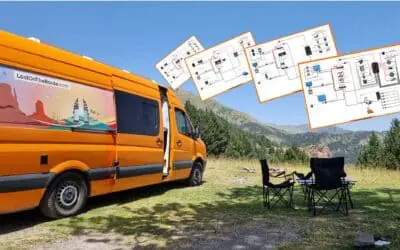



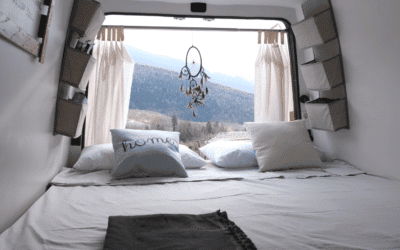

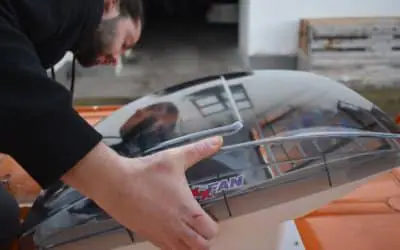

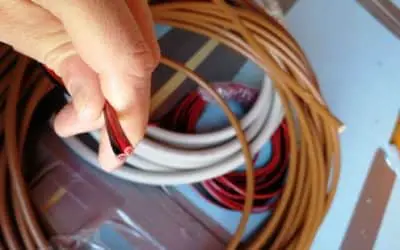




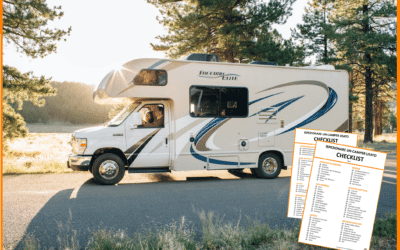



Very informative! Thanks for sharing! I’m looking into anti-burglar glass foil but can’t find much about it. To my suprise also not in your post. Do you know more about this? I only find it for houses.
Keep up the good work! Great content!